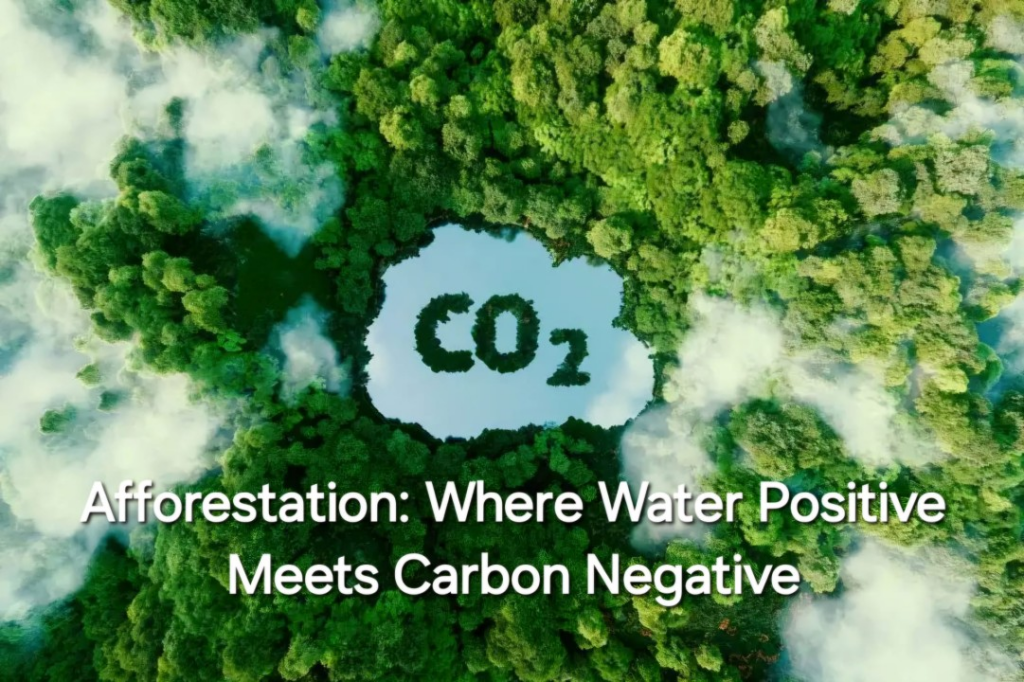
The water reuse for afforestation offers a significant opportunity to promote sustainable practices. This approach not only improves water quality and soil health but also contributes to carbon sequestration. It can be considered a Water Positive and Carbon Negative process, helping to mitigate the effects of climate change and improving soil permeability.
Using treated wastewater in afforestation can significantly enhance the water and carbon storage capacity of forests. These wastewater provide an additional water source for irrigating forest plantations, promoting tree growth and the regeneration of degraded soils.
A World Bank report indicates that 80% of global wastewater is discharged into the environment without adequate treatment. However, this water can be a valuable resource for recovering clean water, energy, and nutrients. This problem can be transformed into a solution, as demonstrated by the Benidorm Water Regeneration Plant in Alicante (Entidad Pública de Saneamiento de Aguas Residuales de la Comunidad Valenciana, EPSAR).
This plant has a production capacity of 19,500 m³/day of purified water from wastewater. This is mixed with 5,000 m³/day of water treated in the secondary treatment plant, utilizing the minerals and nutrients from this stream and minimizing production costs. The result is 24,500 m³/day of water destined for agriculture and the regeneration of river ecosystems and wetlands.
The Canal Bajo del Algar Irrigation Community distributes this water, which has a maximum conductivity for irrigation of 1,300 µS/cm (similar minerality of many municipal drinking waters, even lower than several cities around the world). The reuse process consumes 0.4 kWh/m³, making it extremely competitive in energy terms. This energy efficiency translates to a cost of 0.195 €/m³ for the purified water. To put this in perspective, purifying one liter of fresh water uses approximately the same amount of energy as performing a single internet search.

Forests play a fundamental role in the water cycle, being crucial for the supply of clean freshwater and related ecosystem services. Acting as multitasking water engineers, trees protect against erosion, create humid microclimates, pump and transpire large amounts of water, cool the surrounding environment, and improve water retention and groundwater recharge.
Water storage in forests occurs mainly through tree uptake and soil retention. Trees act as natural sponges, absorbing and releasing water in a regulated manner, helping to maintain the water balance and providing a constant supply of freshwater to surrounding regions.
The water storage capacity varies by tree species, depending on factors like wood capacitance and density. Deciduous species with high capacitance can store and release large amounts of water, while species with low-density wood have a greater capacity to store water, allowing them to survive in drought conditions.
Forests also significantly improve soil permeability. Tree roots create a network of channels in the soil, facilitating rainwater infiltration and increasing aquifer recharge. Additionally, the vegetation cover acts as a protective barrier, reducing erosion caused by wind and rain. This not only maintains soil integrity but also preserves its water storage capacity, contributing to the overall health of the forest ecosystem and its surroundings.
Evapotranspiration is a key process in regulating the water cycle. Trees release water into the atmosphere, contributing to cloud formation and regulating rainfall. This process is fundamental for maintaining the hydrological cycle, as it returns water to the atmosphere, facilitating cloud formation and subsequent precipitation. By increasing forest area through water reuse-based afforestation, the amount of water that evaporates and transpires is increased, improving the hydrological cycle and contributing to the regulation of local rainfall.
The benefits of evapotranspiration extend beyond the forest itself. Forests significantly influence local rainfall patterns, helping to maintain a water balance in surrounding regions. This regulation of rainfall is crucial for climatic stability and water availability in adjacent ecosystems and agricultural areas.
At regional and continental scales, forests create “flying rivers” that ensure rainfall in inland areas of continents. This helps maintain precipitation in many of the world’s major crop-producing regions, highlighting the global importance of forests in food security and ecological stability.
The use of water reuse for afforestation offers additional benefits, such as energy savings and the reduction of greenhouse gas emissions. Less energy is required to treat and distribute drinking water if wastewater are reused for irrigation, resulting in lower carbon emissions associated with these processes.
In conclusion, the protection and sustainable management of forests contribute significantly to global social and ecological stability, offering a natural and efficient solution for water management, climate change mitigation, and ecosystem preservation. water reuse-based afforestation represents an innovative strategy that not only addresses water management but also contributes to the expansion and health of forests, thereby strengthening the hydrological cycle and promoting a more sustainable future.

Continuing with our analysis of the crucial role of forests in the environment, it is important to highlight their function as carbon sinks. Forest systems have the unique ability to capture CO₂ from the atmosphere through photosynthesis, transforming it into biomass and storing it in their structures and soil.
According to IPCC estimates, the living vegetation in forests stores between 450 and 650 gigatonnes of carbon, while forest soils can retain between 1,500 and 2,400 gigatonnes. This storage capacity makes forests a fundamental tool in climate change mitigation.
However, the carbon balance in terrestrial ecosystems is not always positive. Deforestation and land-use changes are responsible for approximately 10% of global CO₂ emissions. On the other hand, forests absorb about one-third of human-origin emissions, acting as net sinks, especially in temperate and boreal latitudes.
Sustainable forest management plays a crucial role in maximizing the potential of forests as carbon sinks. Although there have been debates about the impact of forest management on carbon sequestration capacity, proper planning can ensure forest persistence, increase carbon sequestration capacity, and maintain biodiversity.
In Spain, forests have a significant net sink effect. It is estimated that the net annual sequestration in forest land is approximately 116 megatonnes of CO₂ equivalent, offsetting 11.4% of emissions from other sectors.
Internationally, regulatory frameworks have been established to account for CO₂ emissions and absorptions in the forestry sector. The European Union has adopted regulations that include land use and forestry in its emission reduction targets for 2030.
It is important to recognize that, although forests play a crucial role in climate change mitigation, they cannot fully compensate for anthropogenic emissions. Reducing fossil fuel use and limiting land-use changes remain fundamental to addressing climate change.
In conclusion, forests are not only vital for the water cycle but also essential components in the fight against climate change as carbon sinks. Sustainable forest management, along with conservation policies and forest area expansion, is crucial to maximizing these environmental benefits and contributing to a more sustainable future.

The water reuse for afforestation emerges as an innovative and multifaceted solution to address various environmental and urban challenges. This practice not only improves water management and urban quality of life but also significantly contributes to climate change mitigation.
The Benidorm Water Regeneration Plant, with almost 20 years of operation, demonstrates that this is not a future technology but a proven and effective reality. This example illustrates how long-term vision and early action can generate lasting benefits for communities and the environment.
Water reuse for afforestation offers multiple advantages:
Thanks to water stewardship, Benidorm is one of the most touristic cities in Europe, exceeding 80% hotel occupancy for most of the year, bringing local jobs, and having one of the highest water efficiency indices in Spain. Other cities like Barcelona have not been as fortunate due to their dependence on climate. Without water, there is no tourism, but that does not necessarily imply that more tourists mean more consumption. Quite the opposite. For example, in the last 25 years, Benidorm’s population has grown by 40% to 74,588 registered residents, while tourist overnight stays have also increased by over 25%, reaching 15.3 million stays last year. Despite this, water consumption in the same period has been reduced by around 18%. This impacts not only socially but also economically, as Alicante leads the country in foreign housing demand in 2023, with 20,770 sales, 43.95% of the total, and has been rising since the last available quarters. Thus, the Valencian Community doubled the national average of foreign housing demand in 2023. While in Spain the percentage of foreigners who bought homes reached 14.9%, the highest in the historical series, in the Valencian Community this rose to 29.26%.
This strategy proves to be both “Water Positive” and “Carbon Negative,” offering a comprehensive solution to multiple environmental challenges simultaneously.

In conclusion, the protection and sustainable management of forests contribute significantly to global social and ecological stability, offering a natural and efficient solution for water management, climate change mitigation, and ecosystem preservation. water reuse-based afforestation represents an innovative strategy that not only addresses water management but also contributes to the expansion and health of forests, thereby strengthening the hydrological cycle and promoting a more sustainable future.
Following the example of what this city did nearly 20 years ago, let’s take action today. This underlines the urgency of implementing proven solutions such as water reuse afforestation, leveraging the lessons learned from pioneering projects like Benidorm to build a more sustainable and resilient future.
As a final reflection, we can adapt the phrase: “The best time to secure our water resources was 20 years ago. The second-best time is now.” This underlines the urgency of implementing proven solutions such as water reuse afforestation, leveraging the lessons learned from pioneering projects like Benidorm to build a more sustainable and resilient future.
#climatechange #sustainability #waterpositive #netzero
